When it comes to our beautiful dog companions we want to make sure that they are as healthy as they can be. This includes every part of our dogs, so today, I am writing all about dog teeth!
Dental hygiene is a very important aspect of care for your energetic and lovable dog! Keeping their teeth healthy and clean as well as going through the puppy teething stage can be challenging at times, but don’t worry, this article will give you all the tips and tricks that you need to care for your dog’s teeth!
Do dogs have bad teeth?
Depending on the breed your dog may have a genetic disposition to have dental issues. Small dogs generally have more teeth problems. They often struggle like other dog breeds that have overcrowded teeth or overbites and underbites. Larger dogs tend to have less problems with their teeth.
When teeth are difficult to keep clean or have genetic issues plaque may start to build up which can lead to swollen gums (gingivitis) and if left untreated will start to cause tooth decay and infection of the gums and teeth. This can happen if your dog’s teeth are not being taken care of properly and consistently.
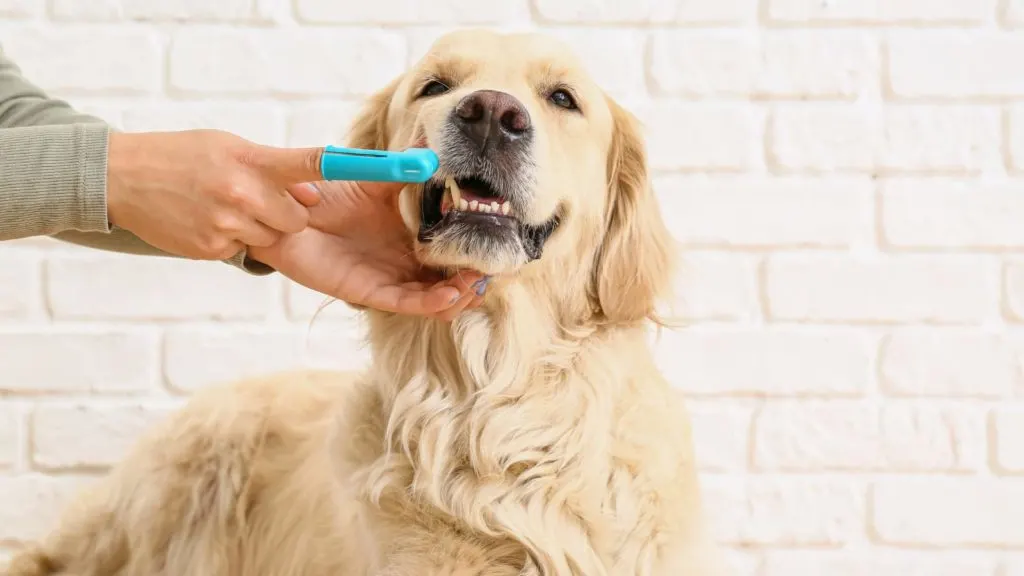
It is important to employ proper dental care for your dog starting at a young age.
Surprising fact: On average 80% of dogs have some form of dental disease by the time they are 2 years old.
If your dog’s tooth disease progresses far enough it can cause serious damage to your dog’s organs. Untreated dental problems can even shorten your dog’s lifespan by up to 3 years.
What are some common dog teeth problems?
Dental disease is the biggest concern for your dog’s teeth. If your dog has severe enough dental disease it can cause tooth decay, the gums to recede and the teeth to start falling out.
Not only is this painful for your dog it can also have an impact on his heart and other organs.
Disclaimer: This post may contain affiliate links. We only recommend high-quality products that are used and recommended by real owners. If you use these links to buy something we earn a small commission.
Interestingly dogs don’t get cavities, but they still can have quite a bit of plague build up on their teeth.
Why is my Dogs Teeth Chattering
The most common cause for your dog’s teeth chattering is periodontal disease. This is a painful condition where the gums become inflamed and bacteria eventually deteriorates the teeth, bones and tissue. Chattering can also be caused by sensitive teeth due to a loss of tooth enamel.
Our dogs tend to do their best at hiding any kind of pain they are in until it gets pretty bad, but oral pain can be a big trigger in your dog’s chattering behavior. This could be due to injury or a more serious dental problem.
If this is a new behavior it is always best to take your dog in for a visit with your vet.
Pro tip: If you are not able to get a hold of a vet near you, or you want to avoid an unnecessary ER trip, there are online resources that you can turn to. Here is our best recommendation!
24/7 Online Vet Appointments – Ask a Vet – Vetster

Why we love it:
🐾 Answers 24/7!
🐾 No waiting!
🐾 Get Answers Online with Local Vets!
🐾 Quick Response Time!
🐾 Easy Sign UP!
Although dental disease may be the most common reason for your dog’s teeth to be chattering it’s not the only possibility. You will want to be very observant of when your dog is doing it. The context could give you some better clues as to why.
Some dogs may shake, or chatter their teeth when they are feeling anxiety or stress. This might be a coping mechanism for your dog when it is in a new situation or around new people.

If your dog is really high energy and gets over-excited whenever he knows there is a treat coming or they see you get out their favorite toy this could induce the teeth chattering or grinding.
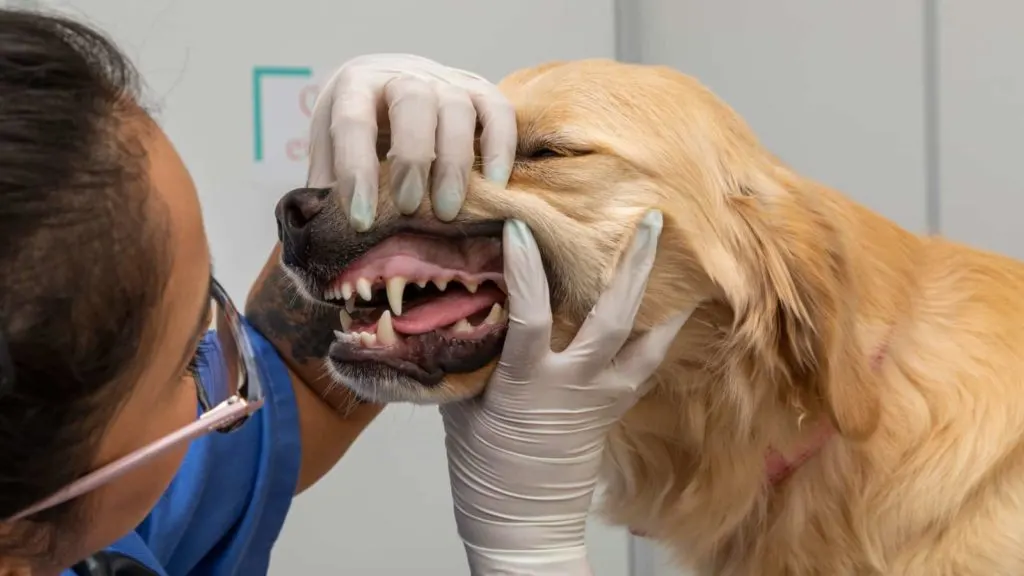
Dog teeth falling out
Your older dog’s teeth falling out is due to periodontal disease. This has happened because the plaque and gingivitis have gotten so severe that your dog’s teeth have started to rot and the gums will release their hold on the rotten teeth.
If your puppy is losing its teeth there is no need to worry, but if your dog is older than 1 year and losing teeth this can be cause for major concern!
If you have a dog rescue that has been poorly taken care of chances are it may have a few missing teeth. The best way forward is to get your dog’s teeth cleaned by a vet, then make sure to keep up with routine dental care going forward.
Why is my Dogs tooth broken?
Broken teeth can be a common occurrence and can be very uncomfortable for your dog.
If your dog has had any kind of impact to their mouth, either from being hit by something or from running into something it could cause a broken or chipped tooth.
They could also break a tooth by chewing on something too hard. This is why I always tell my student to be careful about what they allow their dogs to chew on. It is recommended that your dog doesn’t chew on hard things like antlers, bones, or other hard and non-bendable items.
Signs your dog has a chipped or cracked tooth.
- Eating on one side of his mouth.
- Not eating hard food.
- Not chewing on his favorite chew toys.
- Swelling in his face or gums.
- Excessive drooling.
- Pawing or itching as his face or mouth.
- Not wanting or letting you touch his face.
Broken or chipped teeth can cause your dog serious pain and problems with an infection later on. It’s important that it is treated as soon as possible to prevent more complications. The severity of the broken or chipped tooth will dictate the course of treatment. Your vet will do an assessment and suggest a course of action.
If it is a surface chip the tooth should be able to be repaired fairly easily. If the root is exposed then your dog will likely need a root canal. Your vet will need to sedate your dog in order to do this safely.
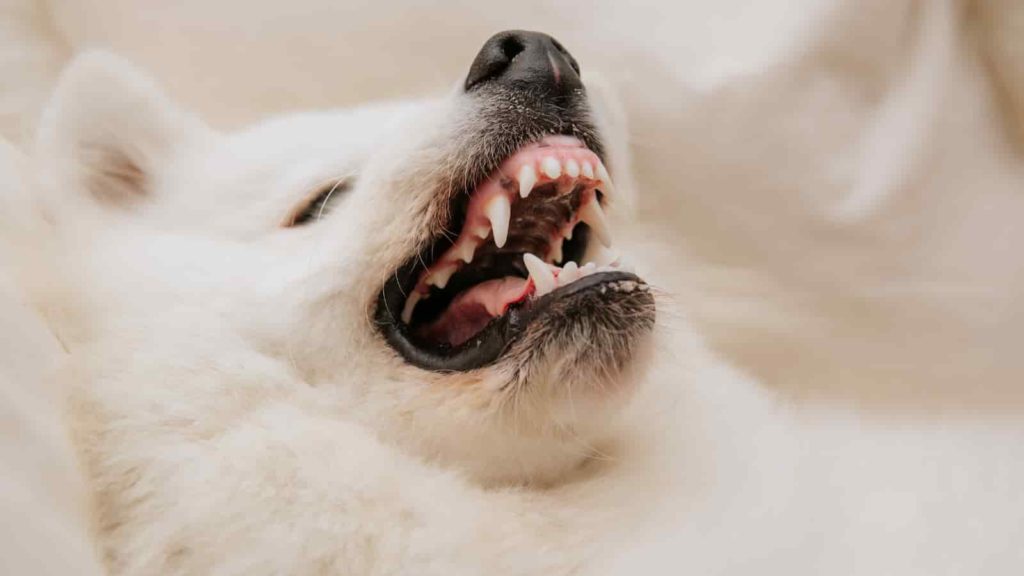
Bad breath in your dog
The most common cause of bad breath (halitosis) in your dog is periodontal disease from tartar buildup because of bad oral hygiene. Bacteria will feed on the build-up of plaque which causes a disgusting sulfur smell. This will grow worse over time if the problem is not addressed.
The best way to get rid of your dog’s nasty-smelling breath is to address their oral hygiene routine.
If the plaque and tartar have built up to a degree that you are not able to remove it yourself by brushing and other tactics (discussed below), you may need to take your dog to the vet for a professional cleaning.
If a cleaning is necessary, your vet will need to give your dog general anesthesia for the procedure so that they can gain easy access to their mouth without the worry of being bitten or having your pup resist.
He or she will then use dental tools relatively similar to the tools that are used on us at the dentist to scale and scrape the plaque from your dog’s teeth. This will also allow them to see if there are any teeth that are loose or rotting and may need to be removed.
This cleaning will help to reduce gingivitis (the swelling on your dog’s gums) as well as the nasty bacteria that cause bad breath.
You will want to be sure to keep a good oral hygiene routine at home afterward to prevent the plaque from returning.
If your dog needs a dental cleaning, this article from the Spruce Pets can help you prepare for and understand what that process entails. Getting a Professional Teeth Cleaning for Your Dog (thesprucepets.com)
Other ways to help reduce dog’s bad breath
There are some foods that can really help out with naturally scraping plaque off our dog’s teeth as well as freshening breath.
Carrots – as your dog chews on the carrots it will work to scrape the plaque off, plus they get the added benefits of the nutrients and fiber that carrots provide as well as their natural ability to help get rid of worms.
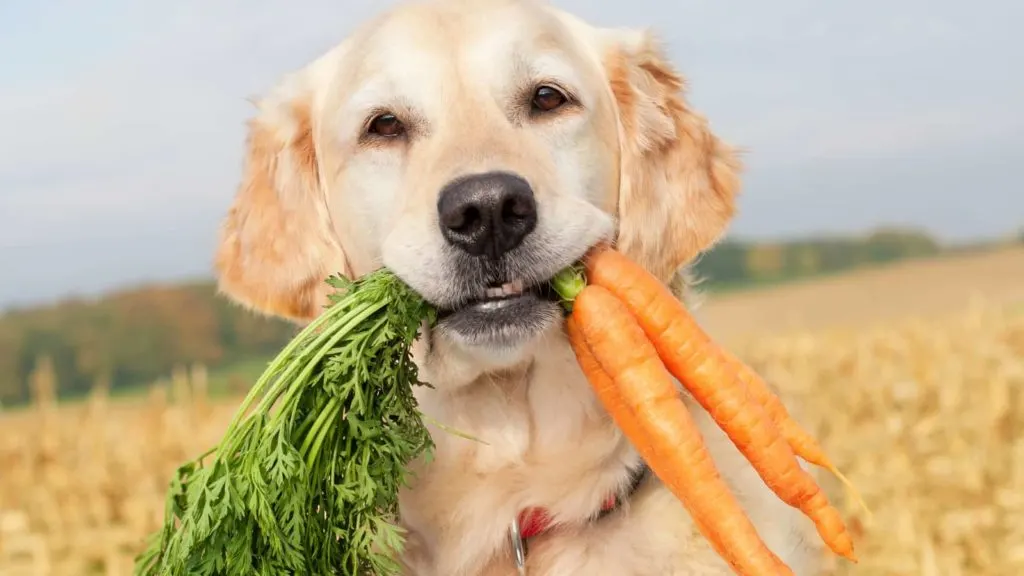
Parsley – This is an amazing herb that you can sprinkle on your dog’s dog food. It has a minty fresh smell and has been proven to battle the sulfur compounds that cause bad breath.
Coconut Oil – Rubbing some coconut oil on your dog’s teeth every day is proven to help prevent the buildup of plaque that causes bad breath. Coconut oil has many amazing powers including antimicrobial and antibacterial (It prevents and kills the bad stuff).
Gently rubbing coconut oil on your dog’s teeth each day can be especially helpful if your dog is resistant to getting its teeth brushed.
This can help your dog get used to having his teeth touched as you slowly work to transition to a toothbrush.
You can read more about the benefits of coconut oil from this article on Healthline. Why Coconut Oil Is Good for Your Teeth (healthline.com)
How to keep your dog’s teeth clean
- Start by getting your dog puppy used to having its gums touched and looked over at a young age. When you bring a new puppy home use coconut oil on your finger to rub on your dog’s teeth and gums each day.
It’s best to do this when they are tired or sleepy. Be sure to watch out for nipping and biting which your dog will surely want to do.
Reward your dog with praise and a small treat when it lets you do this process with ease. - Provide your Shetland with lots of chew toys, (affiliate link) not only will this help you keep them from chewing on undesired things in your house, it will help them keep their teeth clean by the scraping motion that they do as they chew.
Specifically, dental chew toys can also be very helpful to remove plaque from your dog’s teeth. - You should start brushing your dog’s teeth around 12 weeks old. It’s important to start a habit of daily brushing (if not daily then at least 2-3 times a week). Using a pet toothbrush like this as well as a good dog toothpaste is important.
- Use a dental powder cleanser like this one on amazon (affiliate link). This is one of the easiest ways to help your dog’s teeth stay clean. You just add it to their water and you are done!
- Make a consistent effort. Taking care of oral hygiene once and a while will not be good enough for your lovable dog companion. You need to make it a daily/weekly habit so that their teeth will not go bad over time.
How to brush your dog’s teeth
Do dogs have good teeth?
Dogs can have good and healthy teeth if they are well taken care of. Brushing them daily is important. If your dog’s teeth are white, their gums are pink, and they don’t have smelly breath then your dog‘s teeth are likely healthy.
Taking a look at your dog’s teeth every few weeks will help you to keep on top of the dental hygiene and spot signs of problems early on.
Warning: If your dog is prone to biting or is easily startled seek guidance from your vet or a professional dog trainer before following these steps.
When your dog is calm or sleeping, gently lift the flap of skin on the side of your dog’s mouth in order to inspect their gums.
Never put your hand inside your dog’s mouth, even if your dog is normally calm and doesn’t tend to bite.
You will be looking to make sure that their teeth are white and if there is any brown, grey, or black buildup on their teeth how bad it is, and where it is.
You can look at their gums and are wanting to see light pink, any darker pink coloring or red tint can be an indication of gum disease and you will want to schedule a visit with your vet.
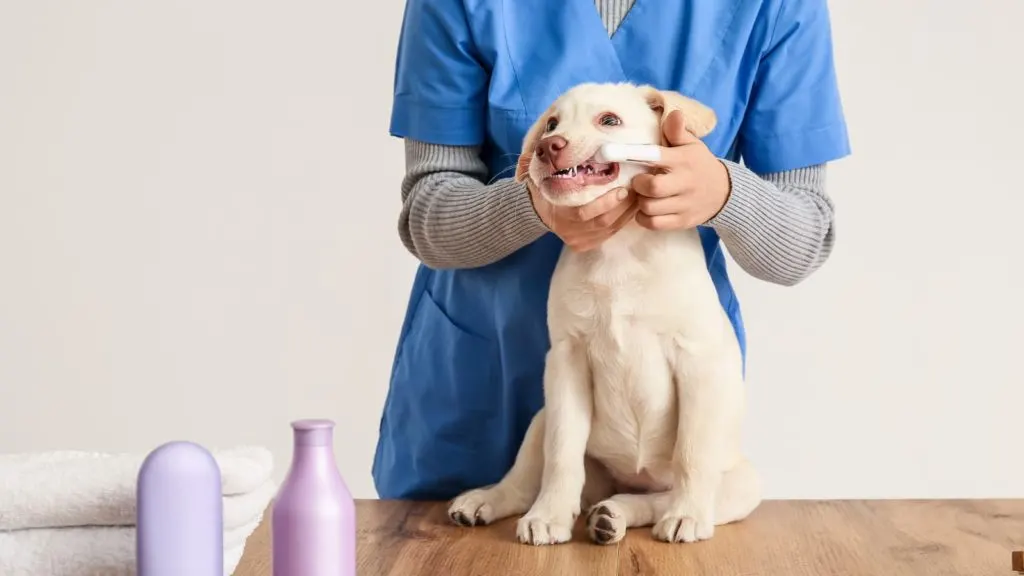
Can I whiten my dog’s teeth?
The best way to keep your dog’s teeth white is to care for their teeth by regular brushing as well as using the other tactics talked about in this article.
If you have been working towards good dental care and need some extra help getting your dogs teeth white try this all-in-one kit that many dog owners have found success in using to keep their dogs teeth sparkling white!
How many teeth do dogs have?
Puppies are born with no teeth but gain 28 baby teeth by 6-8 weeks of age. An adult dog will have a total of 42 teeth including twelve incisors (for grasping), four canines (for tearing), sixteen premolars, and 8 molars (for grinding).
Dog teething timeline
Being a parent of a new dog puppy can produce all sorts of questions from why is my dog constantly licking, to why is my puppy crying all the time. Knowing more about their expected development can help ease some worries and concerns we might have.
If it’s been a while since you have had a puppy or if this is your first experience raising a puppy you may be surprised to know that your puppy’s teeth will fall out. Just like their human counterparts around pre-school age, we start losing our baby teeth, our puppies are going to lose their teeth and grow adult ones as well.
So to help you with this here is a detailed timeline of what you can expect while your puppy is teething.
Please remember that every dog is different so even though this is a good estimate your dog may not follow it exactly.
Newborn: Your puppy will be born with what looks like no teeth at all, but when he reaches 2 to 4 weeks old at the same time his eyes start to open his little baby teeth will start popping through.
Around 6-8 weeks your puppy should have all his baby teeth and will start weening from his mother’s milk while learning to eat soft moist puppy food.
Around 12-16 weeks old as you have recently brought your puppy home and are getting to know them better he will start to lose his baby teeth. It usually starts with the incisors and you will probably notice little rice-sized doggy teeth falling out everywhere.
By 5 months old your puppy will have lost most of its baby teeth and by 6 months old it will have lost all its baby teeth and grown in all its adult teeth.
At 6 months you should have your vet examine your dog teeth to check that all the baby teeth are gone and that the adult teeth have grown in properly.
As your puppy grows you should get your dog used to you gently placing your hand around his mouth and gums. This is the start of socializing your dog and will be helpful to prepare them for getting their teeth brushed and clean.

How to help my teething dog puppy
Luckily the teething puppy stage doesn’t last too long. I know it does feel like it’s going on forever when you are in the thick of it, but it usually gets much better around the time your puppy is 6 months old.
Even though it may be short it can be hard to make it through the puppy teething stage. Having a puppy is a lot of work and it’s best to be as proactive as possible when teaching your puppy and helping them adjust to a new life with your family.
Helping them focus their teething troubles on chewing and biting appropriate things (rather than your furniture or fingers) is part of their puppy training.
You can tell your puppy might be having teething pain or discomfort if you notice them whining a lot, biting and chewing on everything, lots of drooling, and of course, the obvious losing teeth and swollen or tender gums.
The best thing you can do is to offer your puppy a variety of puppy teething toys. Toys that offer different textures, different pressures, or different tastes will help your puppy have variety. This can keep your puppy from getting bored and wanting to chew on things that they shouldn’t (like your brand new shoes)
Offering your pup something cold or frozen can help to numb and dull the teething pain they feel. An easy way to do this is to get a clean cloth a little wet and freeze it. A rope toy could also work well for this.
Safety tip: Puppy teeth are super sharp! Be sure to monitor your puppy when chewing and take away any toys or items that start to become shredded or break apart. It would be dangerous for your puppy to swallow any small pieces.
Our favorite toys for a teething puppy
There is a reason that Kong toys are so popular! Not only are they are super versatile as far as the things that you can put inside the middle, but they are the perfect blend of hard/soft and chewy for a teething puppy.
Try putting a mixture of peanut butter and soft puppy food in the middle and freezing it. Your puppy will love it!
This toy is great for teething. Puppies love the texture of the little rubber nubs against their gums. (affiliate links)
My dog’s favorite thing to chew on is bully sticks! You want to make sure that they do it safely, so be sure to have something to hold the end so that when it gets small they don’t accidentally swallow it and choke on it.
A Big Happy Dog Smile!
A dog’s smile is iconic. Those upturned lips are such an endearing feature of this magnificent animal. For the most part their smile is there to help put us at ease and communicate their friendliness, but A dogs smile can actually tell us a lot about them.
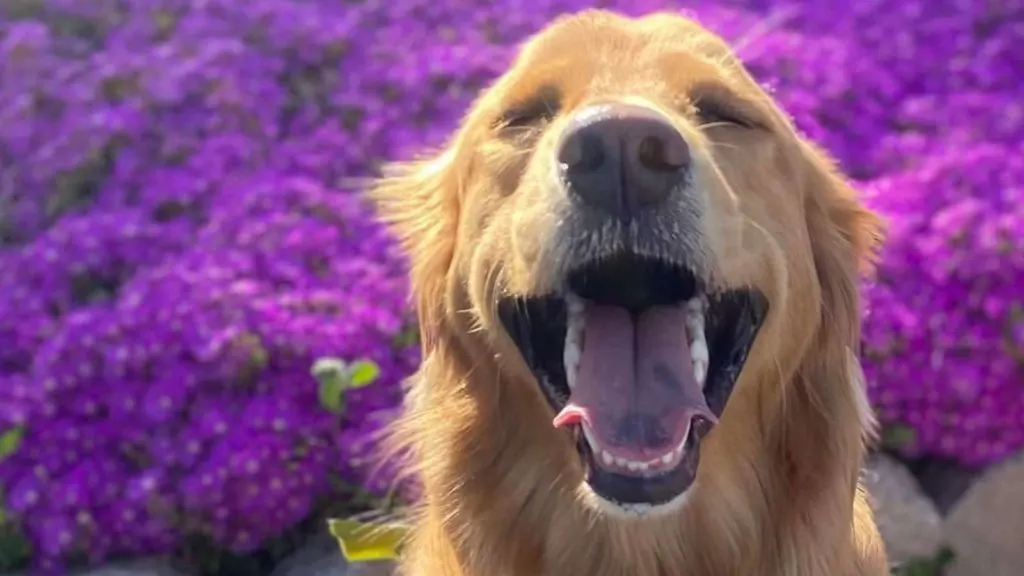
Generally a dog’s smile is from contentment or love. When they are getting praise, attention, pets or scratched they generally have an expression of happiness and contentment that shows on their face as a big smile.
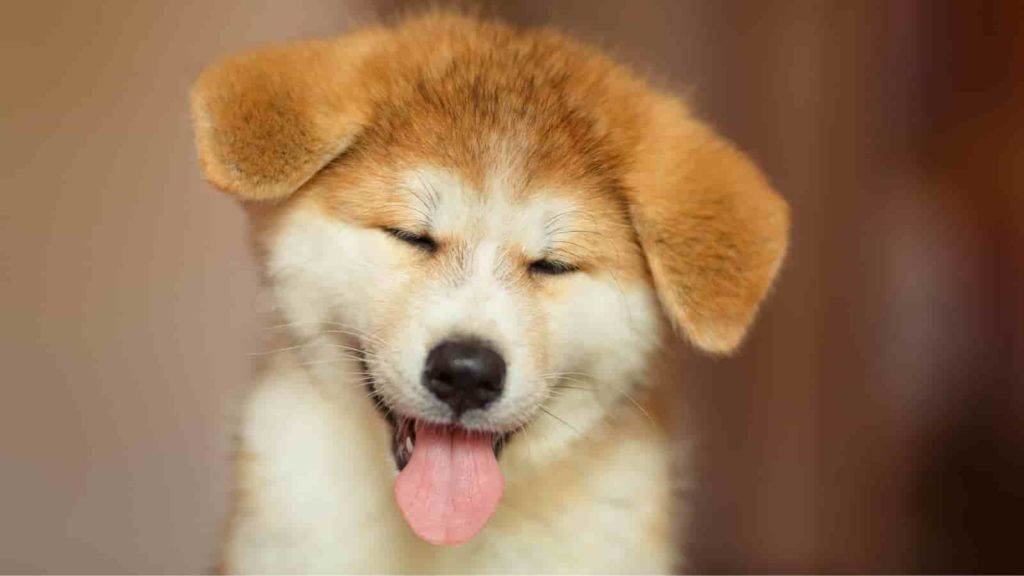
Dogs can smile as a way to show submissiveness. If their eyes are pointing down and they smile but slightly turn their head downward they are submitting that you are the alpha of their pact. This type of smile shows love and respect!
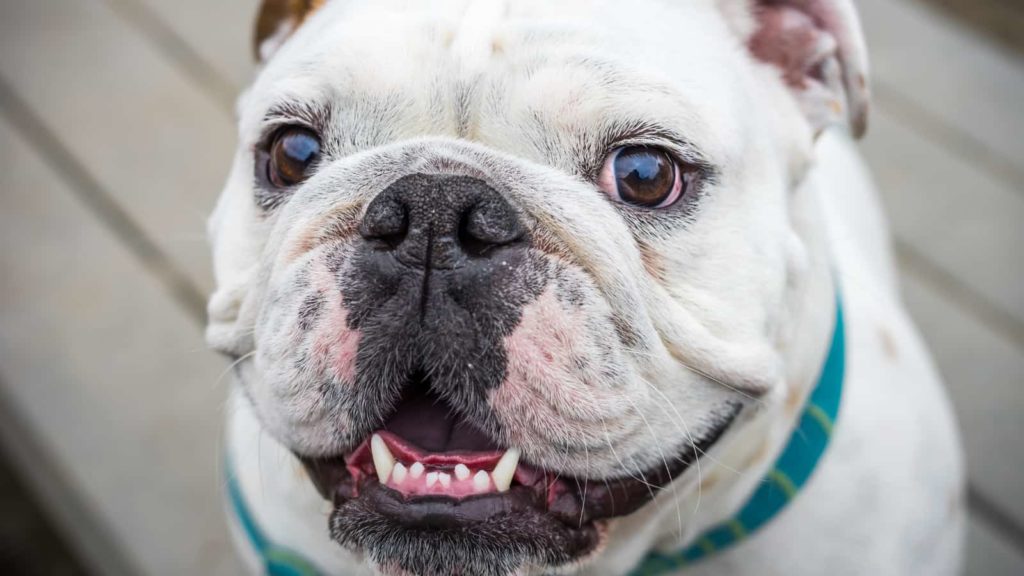
dog’s smile when they are being playful and having fun. This shows that they are enjoying your company and the time you are spending together.
Occasionally a dog will look like they are smiling when really they are feeling aggressive and stressed. This “smile” comes with the barring of their teeth along with snarling and a very tense almost frozen posture.
Noticing a dog’s body language can help you know what they are communicating with their smile!
Read this article next to find out if your dog needs a friend!
While we strive to give the most accurate and helpful information about your pet’s health that we can, this article is meant to be informational only and not medical advice. Never disregard, avoid or delay in obtaining medical advice from your veterinarian or other qualified veterinary health care provider regardless of what you have read on this site or elsewhere.


